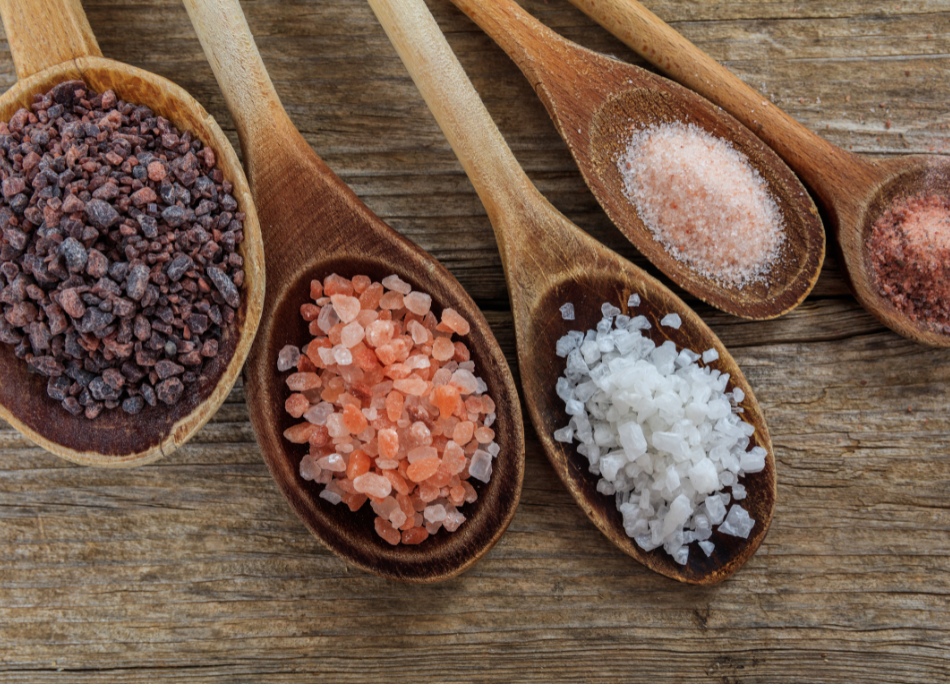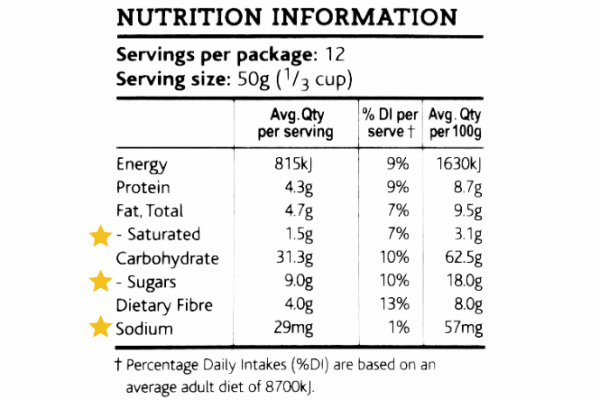Sodium – also known as salt
Key points about sodium (salt)
- Sodium is commonly found in food as salt (sodium chloride).
- Too much salt in your diet raises blood pressure and increases your risk of heart disease, stroke and chronic kidney disease.
- The food you eat can make a big difference to your blood pressure.
- Most of the salt we eat is hidden in processed and packaged foods. Many people also add salt to food out of habit.
- It can take 7 to 12 weeks for your taste buds to adapt to tasting less salty foods.

Salt is a combination of 2 minerals – sodium and chloride. Most sodium we eat is in the form of salt. A small amount of sodium is needed by your body as it helps to keep your fluids and electrolytes balanced and maintains normal blood pressure.
Too much salt in your diet can cause high blood pressure and increases your risk of heart disease, stroke and chronic kidney disease.
Adults should eat no more than 5 g of salt a day (2,000 mg sodium). That's about 1 tsp of salt. This amount is recommended to reduce the risk of high blood pressure, heart disease and stroke.
According to our last national nutrition survey, adults in Aotearoa New Zealand eat about 8.5 g of salt a day (3,400 mg sodium).
There's good evidence to show that a lower salt diet reduces systolic and diastolic blood pressure in people with normal and high blood pressure when compared to a higher sodium diet.
People with high blood pressure, or living with a heart condition, benefit from reducing daily salt intake. There's a greater effect seen in people with high blood pressure. Other lifestyle interventions are also important – these include reducing alcohol intake, managing weight and increasing physical activity.
If you have heart failure you need to avoid excessive amounts of sodium (salt) to reduce congestive symptoms (symptoms suggesting your heart isn't pumping well enough to meet your body's needs, eg, shortness of breath, swelling, heart palpitations). It's recommended that you see a dietitian who can help you with individualised advice.
Over 75% of the salt we eat comes from processed and packaged foods. Salt is added to many foods to add flavour, and can help to preserve food to make it last longer.
Foods high in salt include:
- ham and other processed meats including sausages, bacon, luncheon, salami and corned beef
- packaged snack foods, eg, crackers and chips
- easy-cook packet foods, eg, instant noodles and rice risottos
- pre-made sauces, stocks and condiments, eg, tomato sauce and soy sauce
- takeaway foods
- bread contains a moderate amount of salt, but if you eat a lot of it, it can be a major source of salt in your diet.
Cultural foods high in salt
- Māori: Pork, sausages and processed meats.
- Pacific Peoples: Noodles, corned beef, povi masima, soy sauce.
- Asian: Chinese sausage, noodles, soups, salt-preserved foods (eg, meat, fish, eggs, vegetables), kimchi/pickled vegetables, sauces (eg, teriyaki, hoisin, oyster), miso and pastes (eg, shrimp, soybean and curry).
- South Asian: Samosas, noodles, sausages, snack foods (eg, bhujas, churas, spiced peas, peanuts), packaged curry pastes/mixes, soy sauce, chutney, pickles (achars).
The foods you eat can make a big difference to your blood pressure. Just like learning a new skill, you can gradually retrain your taste buds to enjoy less salt. It can take 7 to 12 weeks for your taste buds to fully adapt to the taste of less salty food.
Here are some ways to cut back:
Eat more whole foods
- These are foods that are close to their natural form and naturally low in salt. Examples are vegetables, fruit, whole grains (eg, oats and brown rice), legumes, unsalted nuts and seeds and fish (eg, tuna and mackerel).
- If you add salt to your food, do so after cooking and once you’ve tried the food first so you don’t add too much.
Make small swaps
- Use lemon, fresh herbs and spices instead of salt, marinades and sauces (eg, soy sauce) to add flavour to your food.
- Choose fruit and vegetables instead of biscuits, chips, crackers, instant noodles, bhuja mix or salted nuts.
- Choose eggs, fish or lean meat instead of processed meats (eg, sausages, ham, luncheon, bacon, canned corned beef and salted beef).
- Make your favourite takeaway foods at home (eg, pizza, burgers, Chinese, Indian, fried chicken, fish and chips). That way you can control the amount of salt they include.
Shop for lower salt foods
- Read food labels to choose healthier foods and eat less salt, especially for foods you eat often (eg, bread, breakfast cereals, cheese).
- When shopping, check the food labels where you will see salt listed as sodium. Compare products and choose the lowest sodium per 100 grams:
- high sodium foods: more than 600 mg of sodium per 100 g
- medium sodium foods: 120 to 600 mg sodium per 100 g
- low sodium foods: less than 120 mg per 100 g.
Also look for foods labelled as 'low salt' , 'salt-reduced', 'unsalted' or 'no added salt'.
The image below shows a nutrition information or food label with sodium at the bottom. Read more about food labels and how to use them.

Image credit: Healthify He Puna Waiora
When you add salt to a dish, always choose iodised salt. Fancy, and often more expensive, sea salt and rock salts often don't contain iodine. Although only required in very small amounts, iodine is an essential nutrient for everyone. Table salt in Aotearoa New Zealand has been iodised (had iodine added) since 1924 to prevent iodine deficiency.
Some salts contain less sodium and more potassium than table salt and are called 'salt substitutes'. There are a few products available and they cost a lot more than regular table salt.
These products may help if you use a lot of salt during cooking and can't use less salt. However, they won't help you to eat less salty foods.
Check with your healthcare provider before using a salt substitute as they contain potassium which isn't suitable for people at risk of high blood potassium (hyperkalaemia), eg, if you have kidney problems or you're taking some medicines.
Salt (sodium) and your heart(external link) Heart Foundation, NZ
How to cut back on salt to boost your heart health(external link) Heart Foundation, NZ
Sodium and heart health position statement(external link) Heart Foundation, NZ
What you need to know about salt(external link) Stroke Foundation NZ
Ultra-processed foods – are they bad for your health?(external link) Heart Foundation, NZ
Hyponatremia – symptoms and causes(external link) Mayo Clinic, US, 2022
Brochures
Salt and blood pressure(external link) Stroke Foundation NZ
References
- Sodium and heart health position statement(external link) Heart Foundation, NZ, 2022
- Eating and activity guidelines for New Zealand adults(external link) Ministry of Health, NZ, updated 2020
- Brand A, Visser ME, Schoonees A, et al. Replacing salt with low-sodium salt substitutes (LSSS) for cardiovascular health in adults, children and pregnant women(external link) Cochrane Database Syst Rev. 2022;8:Art no CD)15207
Credits: Healthify editorial team. Healthify is brought to you by Health Navigator Charitable Trust.
Reviewed by: Lily Henderson, Registered Dietitian
Last reviewed:





